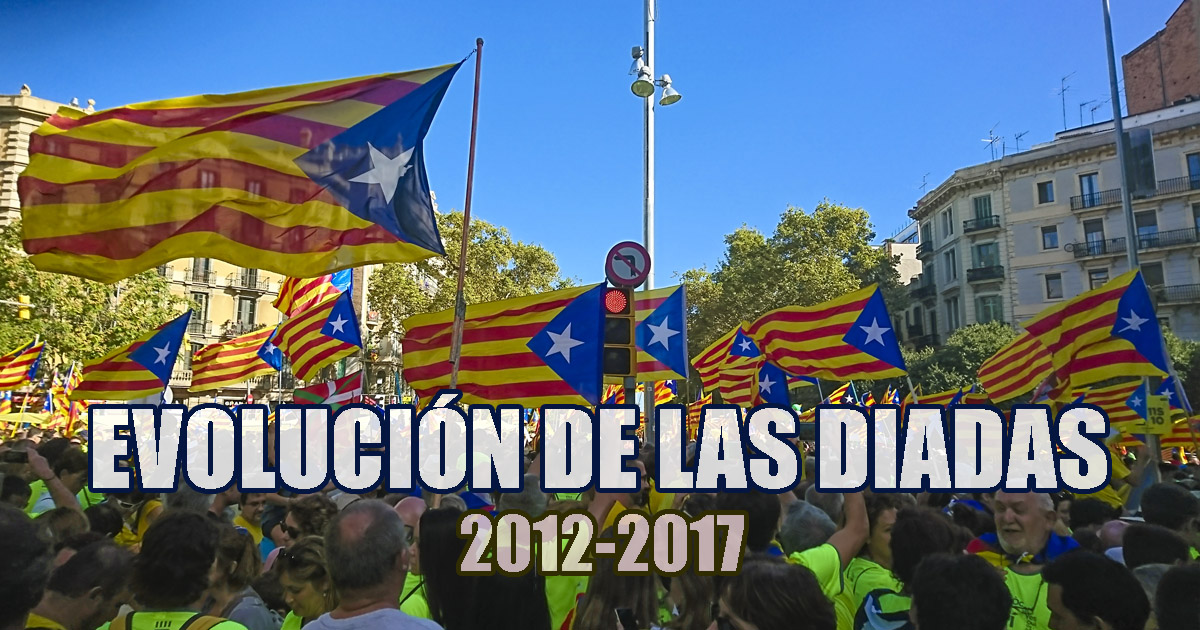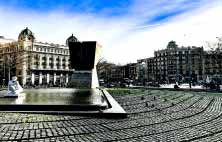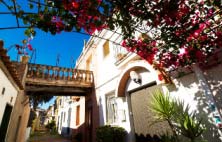Evolution of participation at the Diadas
Infographic
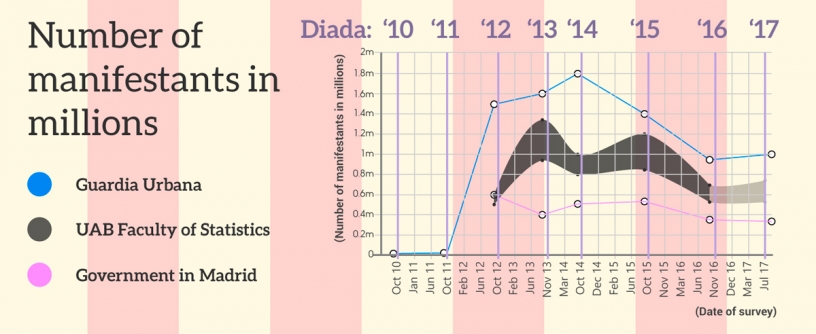
Here we have a graph that shows the evolution of the participation at the National Day of Catalonia — known in Catalan as La Diada — in the last few years. It is well known that depending on who tells the story, the numbers jump up and down… which is what we find in this case.
With the understanding that the number of protestors corresponds to a demand for Catalan independence, we see how from 2011 this feeling of pro-independence was on the rise until it reached a historic peak in 2014.
It is curious how the data differs between the Government of Madrid and the Generalitat (via the City Police). Estimates from statistical experts tend to range between the two.
What is clear is that after the peak, participation decreased in the following years. This is something that all sources note, but with different numbers. We analyse the three sources that count the attendance at the manifestations.
We will see the causes and motives for these movements, analysing each Diada. But first, we look at the sources responsible for counting and how they reach their numbers.
Sources
The highest figures of attendance are those that the organisers push. In this case, the municipal police who are at the disposition of the Generalitat (Catalan Government). They are figures taken by counting from the street, which are used with other methods, like maximum capacity of the area. They are recorded first hand, however, they cannot be regarded as an objective source of data.
Then there are the figures from the opposite side, in this case from the Government of Spain, in Madrid. They are numbers launched with the intention to distort and counter data released from the Generalitat. They are excessively low, so much so that the data tends to lack credibility.
Then in between the two are the figures from experts. This profile — compared to the other two — is much more objective. They simply reflect objective and scientific estimations. They use different methods to count participation. In the case of this graph, the estimations have been calculated by Llorenç Badiella, director of the Applied Statistics Services of UAB.
Methods of calculation
In statements from europapress.es Badiella acknowledged that “citizens feel unprotected by the type of estimates done with political interests”. Therefore, from 2012 he started analysing and applying different methods to count the number of protestors at different Diadas. He says the study has an “objective intention”. There are different statistical methods that needed employed each time, simply each Diada protest happens in a different way.
For example in 2012 there were many protestors moving from inside the crowd. That Diada was very dynamic, so he used the ‘Jacobs method’. This is a methodology that calculates the area that the protest occupies and then divides this area into sections. An estimation of the density of people per square metre is made for each section, then it is multiplied by the number of occupied sections.
In the case of the Diada in 2013, the count was carried out with the help of a "gigaphoto". The protesters constructed a chain of 400km, so they had to use a different method to the usual one. Thanks to a huge photo formed by 107,000 photographs he could estimate the participation of the day.
Finally, for the following years, from 2014 – 2017, he used the ‘slice method’. The protests were more static and the majority of the attendees had been brought together for a concrete hour and at a determined point, placing them in a homogenous manner. In this way and with the help of collaborators, they divide the protest into stripes, one metre wide, an estimation of the number of people in each stripe is made, then multiplied by the distance of the route, giving a strong idea of attendance. It is evident that the figures are not exact — this is always going to be impossible — but according to Badiella, “with very simple tools it is possible to get close to measuring it if you have the desire to make a true, objective calculation.”
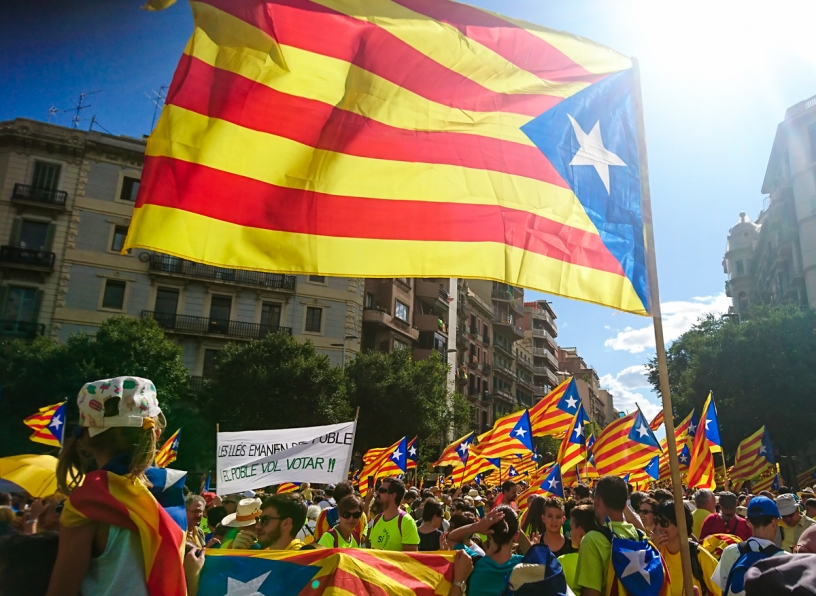
Numerous Diadas (2012-2017)
Diada 2012 — 'Marxa'
According to figures from the Government in Madrid there were 600,000 people. The Generalitat via the city police say it was 1,500,000. Meanwhile, estimations using the Jacob's Method say that there was between 500,000 and 600,000 people that protested on 11 September.
History
The 2012 manifestation is very significant in that, in 2011, just 10,000 people had supported the protest. The chants at the time were different and each one claimed what they were most interested in — some unilateral independence, others a referendum. However, if there was a common denominator, it was the claim that Catalonia was being undermined by the Central Government.
The other reasons as to why strong feelings of pro-independence started was in the rejection of the Statute of Autonomy of Catalonia by the Constitutional Court that had already been approved by the Parliament of Catalonia and Congress of Deputies in Madrid. The Constitutional Court destroyed many of its points; one of the most controversial being the one calling Catalonia a nation. This paralysis of the ‘Estatut’ made more people join the independence cause and so there were more and more people every 11 September at the Diada protests.
As we can see from the graph, the economic crisis and triumph of the PP (Partido Popular) in the elections of November 2011 were also incentives for the march in 2012 before and after the Diadas.
The protest
The protest started at the intersection of Passeig de Gracia and Gran Vía. It advanced through up to Vía Laietana, down towards Passeig d'Isabel II and then journeyed toward the Catalan Parliament.
Protestors overflowed the streets. It resulted in an argument in favour of independence, and so Artur Más, then president of the Generalitat, recognised the sign and called elections for 25 September. In this election, Catalan political parties campaigned for and against a promice to carry out a referendum for the independence of Catalonia if they obtained the majority in Parliament.
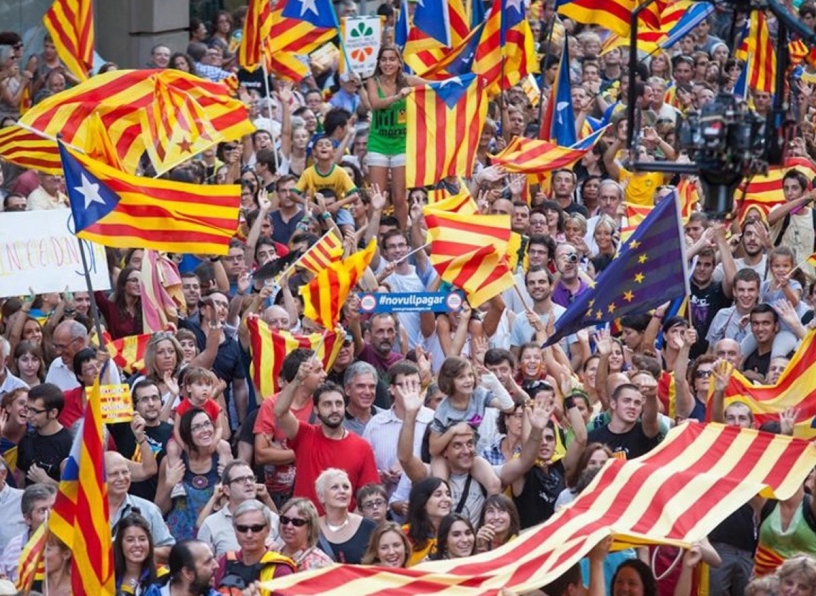
Diada 2013 — Vía Catalana
The Government in Madrid estimated participation by 400,000 people, the Generalitat and police force estimated 1,600,000, and experts estimated between 950,000 and 1,350,000 people. On this occasion, it was promoted by the Asamblea Nacional Catalana (ANC), an association whose objective is to achieve political independence for Catalonia, They organised a human chain of 400km.
Human Chain
Also known as ‘Catalan journey towards independence’, it was a 400km human chain that started in the north in the French town of le Perthus and went down towards Vinaroz, Valencia. It crossed the entirety of Catalonia from north to south.
They mobilised 1,500 buses and there were 30,000 volunteers. About 20 aerial vehicles documented it with more than 800 photographs.
The Catalan people demanded the right to decide. For the first time, the Catalan wing of Partido Popular did not participate in the official acts of celebration for the National Day of Catalonia.
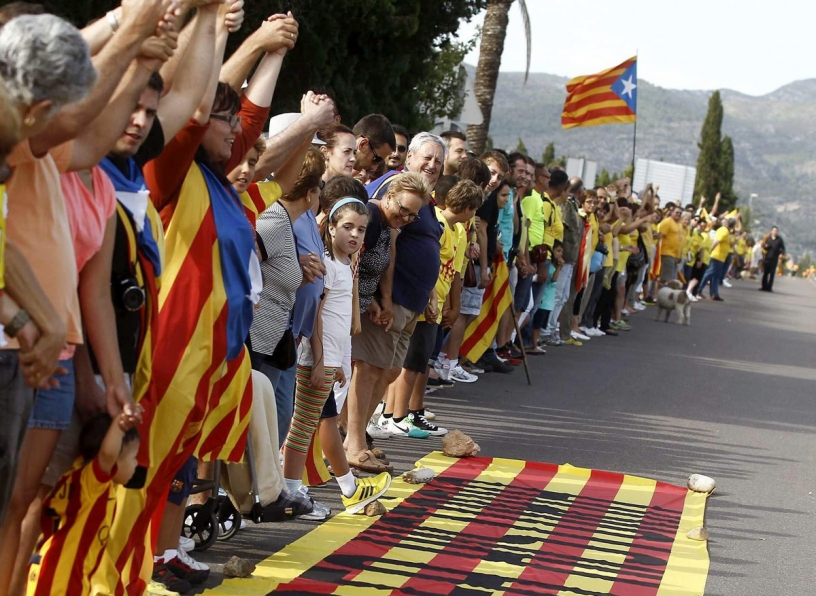
If you come to visit the capital of Catalonia, we will help you to find the best apartments for long term in barcelona. We offer apartments of different types, renovated and well furnished in all areas of Barcelona!
Diada 2014 — The V
According to the Government in Madrid, this year there was between 470,000 and 520,000 people. The Generalitat and municipal police said 1,800,000. Experts stated between 800,000 and 1,000,000. This was the Diada with most participation according to the figures from the Generalitat, but not according to the experts.
Many acts were carried out, but the most significant was the promotion by the ANC and Òmnium Cultural — a political and cultural Catalan entity that promotes the use of the Catalan language — to spread Catalan culture and promote independence. This year it consisted of making a V that could be seen from the sky. The slogan for the protest was ‘Ara és l’hora’ (Now is the time), referring to the following 9 November, when they tried to do a referendum on independence which ended up as a "consultation".
V
The protestors dressed in official t-shirts for the event — either red or yellow — and formed in assigned positions. They occupied Gran Vía and Diagonal. The joint of the V was Plaça de Les Glàries Catalanes. The result was a large 11km V. It called the right to democracy.
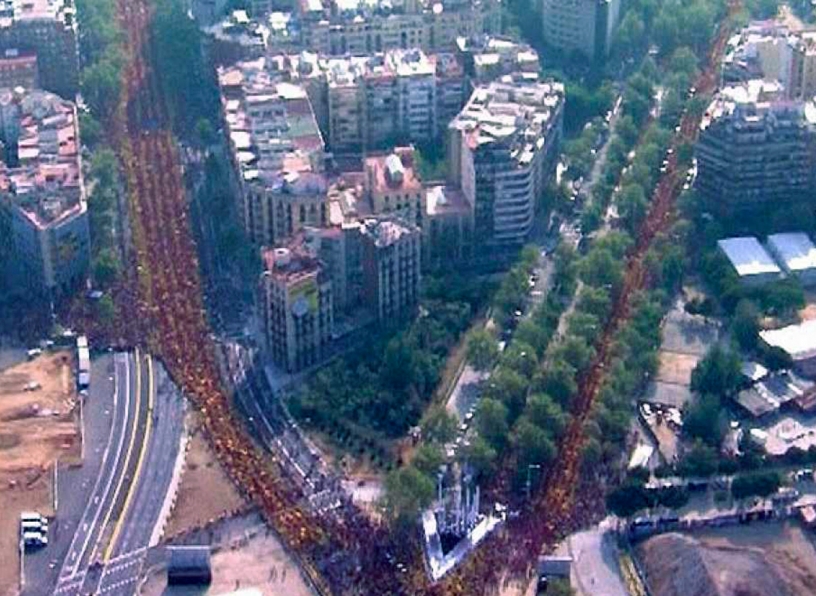
Diada 2015 — Vía Lliure
There were 520,000 people according to the Government in Madrid, 1,400,000 according to the Generalitat and municipal police, and between 850,000 and 1,200,000 according to estimations from experts.
We also see at this Diada an increase of participants compared to the previous year according to data from experts and the Government of Spain. This is shown by the graph. Their figures approach those offered by the Generalitat, who on this year said attendance was lower than the previous year.
Vía Lluire
The idea this time was to make a big pointer to travel through all of Avinguda Meridiana until it reaches the Catalan Parliament. The total distance was 5.2km, which started at the corner of Carrer del Rosselló and reached Ciutadella Park. It started at 17:14, the time that honours the fateful year of 1714, in which on 11 September, Catalonia succumbed to the Bourbons during the War of Succession.
The message from the Generalitat was try to make the Government of Mariano Rajoy in Moncloa open their eyes and get them to talk. A call for dialogue, not to ignore the voice of the Catalan people nor to underestimate them.
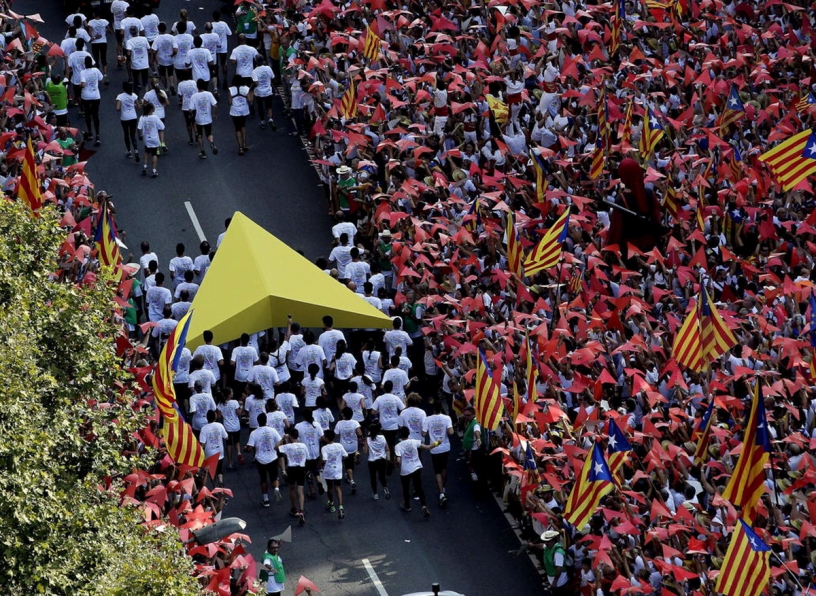
Diada 2016 — 'A punt'
The Government in Madrid spoke of 350,000 people, the Generalitat and municipal police 1,000,000 and experts between 485,000 and 785,000.
The name of this Diada is ‘A punt’ (roughly translates to "Ready to") because the Catalan Government wanted to give the impression that everything is ready for the creation of a new state. Participation continues to fall considerably this year with respect to past years. One reason could be that the event was decentralised. It was celebrated simultaneously in Barcelona, Lleida, Tarragona, Salt (Girona) y Berga (Barcelona). Like at other occasions, it began at 17:14 in commemoration of the year 1714.
Heartbeat
This was the performance of this year, to simulate a heartbeat. The attendees carried yellow cardboard points. After the launch of a rocket, the attendees of the protest rose up and moved to simulate a heartbeat.
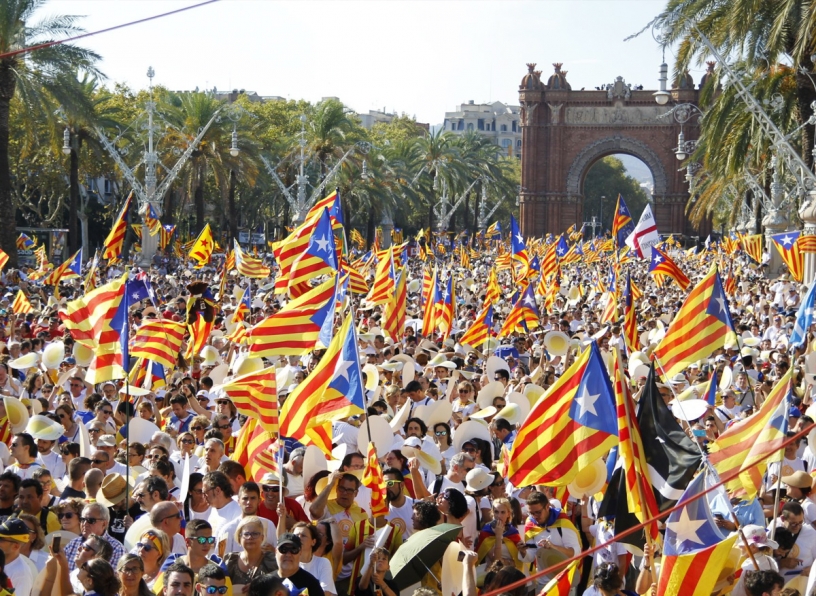
Diada 2017 — The Diada of 'Sí'
On this occasion, the Government Delegation from Madrid in Catalonia said that there was 350,000, while the ANC organisers said that 1,000,000 went out to the streets to shout yes to independence and yes to the referendum that has been called for on 1 October.
This year the Diada proved more tense than on other occasions. This is because on the Generalitat has called a referendum for 1 October that will ask the citizens whether they want an independent state. Anger comes from the Government of Spain, who brand it illegal and unconstitutional, as well as saying that they will stop it by all means.
The push has begun. Nobody will cease. Meanwhile the Catalans shout Yes on the streets. Yes, to at least be able to decide, vote and see what the Catalan people want. Meanwhile, the Government of Mariano Rajoy is only saying No, without opening the door for discussion.
'X — Voting cross'
This manifestation organised by the ANC, had attendants wear fluorescent green shirts. The idea was to carry large cross that would be drawn across the streets of Passeig de Gracia and Carrer de Aragó. At 17:14, banners would cover both the streets across the people, at which point attendants put on the shirt and shone a fluroescent light that could be seen from the sky.
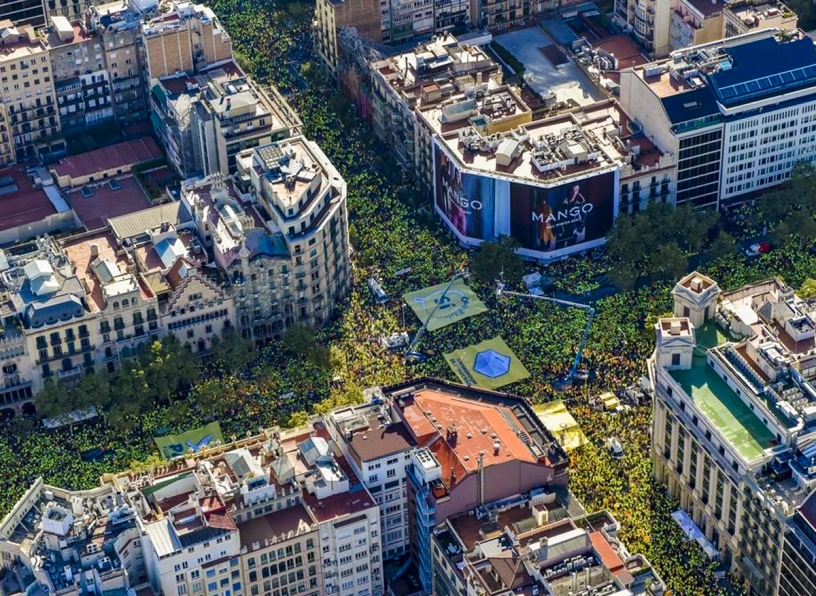
National Day of Catalonia in the media
Just as the figures vary according to who has reported them, the same news is told differently depending on who reports it. Here we have a video that shows the different headlines and covers from newspapers — Spanish and Catalan — from the day after the National Day of Catalonia 2017. The mixed messages sent out by the media are nothing less than confusing.
Excursions in Barcelona
To make the most of Barcelona and fill your trip with unforgettable experiences and emotions, we offer you the excursions through the Catalan capital organized by our friends - the GetYourGuide team. Choose your excursion and fall in love with Barcelona:

